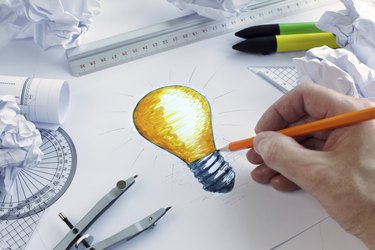
Sometimes tracing paper simply isn't available when you need to trace an image. Instead of putting off your project for another time, trace that paper-based image another way. Light tables, graphite, chalk and even charcoal allow you to trace any paper-based images or designs, sans tracing paper.
Light
Video of the Day
Light tables and light boxes are box-like devices with smooth, translucent tops, each with a light source beneath or inside. Place the original image you wish to trace atop the light table, turn the table's light on and place a clean sheet of paper atop the original image.
Video of the Day
Both the original image and your fresh sheet of paper must be thin enough to allow light to shine through, otherwise you won't be able to see the lines of the original image to trace them. Regular copy paper, notebook paper and some art papers are thin enough to allow light through.
If you have access to a window on a sunny day, use sunlight as your light source instead. Tape the original image onto the window with painter's tape, place your fresh paper atop that, then trace the original design.
Pencil
A regular pencil allows you to trace any paper-based image onto another sheet of paper or even onto wood and cardboard -- it works on any surface that you can write on easily with a pencil. Rub a dull, soft pencil tip over the back side of the paper containing the image you wish to trace.
Don't cover the entire paper -- focus on the areas where the drawing, text or illustration exists on the other side. Rub the pencil's graphite on heavily; the heavier the pencil layer, the more likely it will transfer. Place the pencil-rubbed paper image-side up atop the surface where you wish to create the tracing.
Trace the lines directly on the original image using a ball-point pen or dull pencil. If you prefer not to draw upon the original image, use a photocopy instead. The pressure from the pen or pencil transfers the graphite from the back of the paper onto the project surface.
Graphite
Graphite paper -- a special type of transfer paper featuring the same material in pencil lead -- offers a way to trace images similar to creating carbon copies. Place a sheet of graphite transfer paper graphite-side down atop the project surface, then place the original image atop the graphite paper.
Trace the details of the image with a ball-point pen or dull pencil. Graphite from the transfer paper rubs off onto the project surface and can be erased, if necessary. For best results, tape the transfer paper down with painter's tape or archival artist's tape to keep it from moving as you trace the design.
Chalk and Charcoal
Either chalk, pastels or an artist's charcoal stick may be used to create a quick rubbing over the paper on the flip side of the image you wish to trace. If using chalk or pastels, choose a color that stands out against the desired project surface -- white chalk on a white canvas will be nearly impossible to see.
Afterwards, position the original image face-up on the project surface and trace over it with a ball-point pen or dull pencil. For a slightly less messy version, use a charcoal stick to trace the lines of your original image, flip the image over and rub the back side of the paper with your hand. This technique creates a reverse of the original image, so photocopy a reverse version before applying charcoal if the alignment matters.